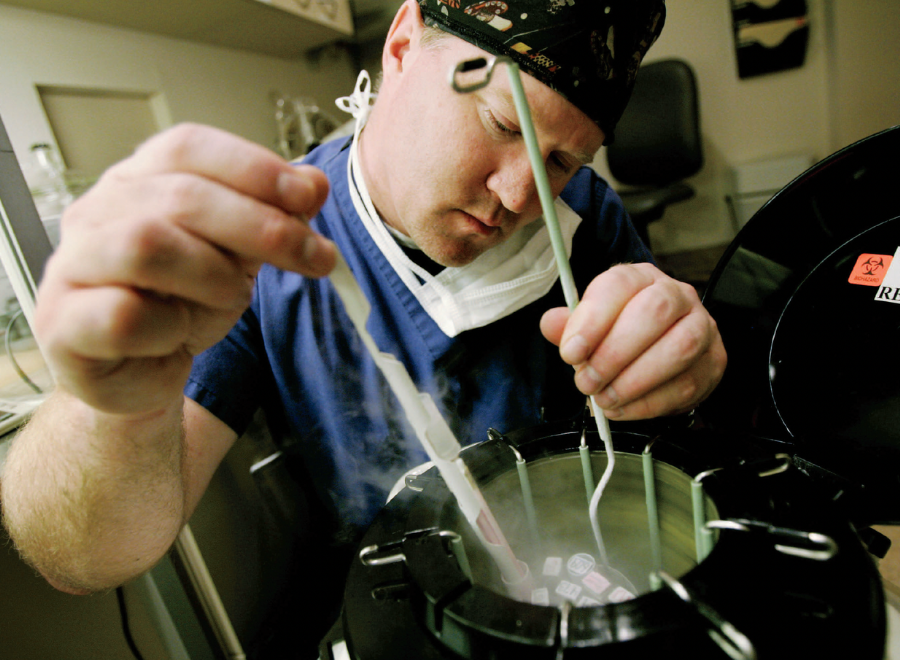In the year 2039, anti-clone riots break out in the streets of Los Angeles after a cloned Hillary Clinton is inaugurated as president of the United States. It becomes a fad among the extremely wealthy to build cloned versions of themselves on Mars. Though disease has been stamped out in the developed world, it persists in nations that can’t afford stem cell technology. International courts approve a plan to eliminate contagious diseases by culling the humans who harbour them.
On the other hand, maybe it won’t be so bad. Possibly, in the year 2039, the United Nations adds cancer to its growing list of diseases that stem cell technology has defeated, which already includes Alzheimer’s and multiple sclerosis. The Canadian census reveals that the average life expectancy is now at 119. And Michael J. Fox wins the best actor Oscar award for his performance in the biopic Conquering Lou Gehrig’s: The Stephen Hawking Story.
You may unsubscribe from any of our newsletters at any time.
Making predictions about how stem cell technology will affect our world 30 years from now is barely better than crystal-ball gazing. But many prominent researchers believe we are on the cusp of revolutionary medical technologies, and indeed, stem cells have already begun to prove themselves in treatments such as bone marrow transplants.
One of Canada’s leading stem cell researchers is Michael Rudnicki, the scientific director of the Stem Cell Network in Ottawa. “Stem cell research is paving the road for regenerative medicine to enter the clinic and transform the practice of medicine,” he says. “Many of us believe that this will allow the treatment or even the curing of diseases that now plague humans. It will have a very profound impact on human health and ease human suffering in ways we really can’t anticipate.”
Alas, public fixation on the controversy surrounding stem cells derived from embryos has completely overshadowed other considerations — ethical debates fraught with uncertainties that need to be resolved long before we arrive at 2039. For example, who financed the basic research and clinical trials? Who owns the emerging biotechnologies? Who oversees and regulates those technologies? How do we ensure fair access to life-saving treatments?
Millions of dollars are being spent in dozens of countries to get stem cell technology from the lab bench to the bedside. The Canadian Institutes of Health Research, one of the country’s largest research funding agencies, spends around $60 million a year on stem cell research. But it won’t be enough. Between the university lab and the doctor’s clinic, someone has to pay for scores of costly clinical trials hat prove safety and efficacy.
Rosario Isasi studies the legal ramifications of stem cell exploration as a research associate with the University of Montreal’s Genetics and Society Project in the faculty of law. She refers to this stage of the biotechnology life cycle as “the valley of death” because it is so expensive and unpredictable, making corporations very cautious to get involved. Isasi fears that if governments don’t give clinical trials more funding, biotech companies will continue to shy away and potentially revolutionary medical technologies will never develop.
This leads to another dilemma. One of the main ways that biotech companies get rewarded for investment in clinical research is through the issuing of patents that protect the development of their pharmaceuticals and require anyone using their patented material to pay them. In Europe, a recent court verdict said that embryonic-based stem cell technology cannot be patented, but other forms of the technology can be. Canada, however, is still unclear whether it will allow stem cell technology patents.
While some fear that patenting life could lead to a dystopian future where large multinational companies control human lives, there is a more realistic and pressing concern: once a technology is patented, other companies will have to pay to use that research, making the process of technological development much more complicated and expensive.
“The purpose of the patent system is to reward innovation and to accelerate invention,” says Chris MacDonald, a bioethicist at Saint Mary’s University in Halifax. “There are worries about the breadth of patents, and if they are too broad they could put limits on what other researchers can do that in effect rob us of the very benefit of having a patent system, which was to stimulate innovation.”
Another concern is that stem cell technology will get into the wrong hands and, before you know it, human clones will be popping up everywhere. Though great fodder for Hollywood screenwriters (and magazine journalists), it’s extremely unlikely. Isasi has studied the rules and regulations in every country where stem cell research is being done and says it is very strictly overseen by ethics committees, government agencies and the law. Of the nearly three dozen countries that research stem cells, Isasi has found tight and functional oversight mechanisms in each.
For example, in the United Kingdom, reputed as being lax when it comes to regulating research, it is against the law to use stem cells for trivial purposes. The country requires researchers to prove that their work will improve upon existing technologies or knowledge. The ban on human reproductive cloning is also universal, says Isasi, who was a consultant to the United Nations’ 2005 declaration on human cloning.
But MacDonald sees the cloning issue differently. In 1996, Dolly the sheep was cloned, but it took until 2002 for the Canadian government to pass legislation making human cloning illegal. In that six-year period, he points out, humans could have been cloned in Canada, and it would have been legal. He believes one of the main reasons why they weren’t was because business leaders didn’t think there was money in it.
“A lot of the important and interesting decisions that get made about biotechnology are inevitably made by corporate decision-makers,” MacDonald says. “There are natural limits on how quickly public policy makers can react, and biotech is such a fast-moving field that even if government wanted to and knew how, it would be quite difficult for them to keep up with all the advances in the field and pass regulations.”
Finally, if we hope to reach our utopian future where cancer, Alzheimer’s and numerous other diseases are relegated to the medical history textbooks, we must ensure universal access to health care. Like many new and experimental treatments, the cost for early stem cell treatments is sure to be exorbitant.
“Markets are very good at producing things and producing them relatively efficiently, but what they’re not particularly good at is solving hard problems related to distributive justice,” says MacDonald, who has studied how biotech companies price new pharmaceuticals. “There’s nothing in the market mechanism that works particularly to ensure that everyone gets access to an important resource. That’s a job that governments are much better attuned for.”
Politicians will decide what stem cell technologies are covered by provincial health care and who qualifies for access. And while it will take decades for most of the stem cell research currently being done to reach the doctor’s office, the policies that allow for a smooth transition should be created now. After all, if a life-threatening disease could suddenly be cured with an injection of stem cells, who would want to wait while politicians debate it in question period?
***
This story first appeared in The United Church Observer’s June 2009 issue with the title “Stem cells: the next battlefronts.”














